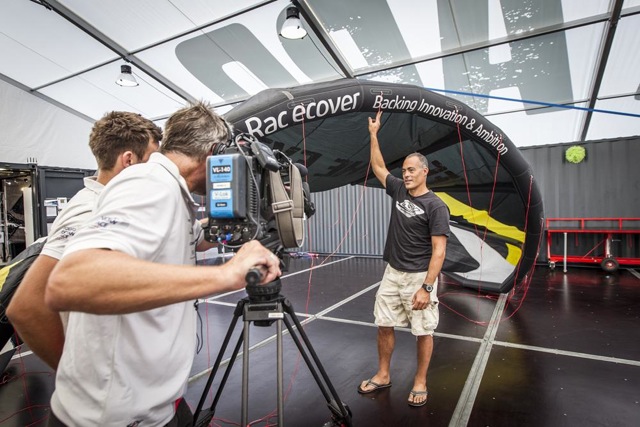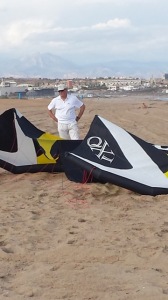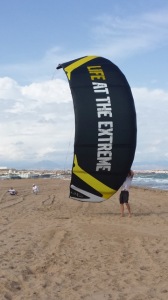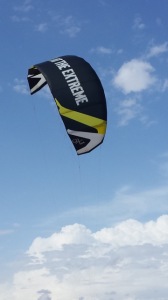How the insurance industry pushed for the offshore Rescue Kite
Published on November 21st, 2014
Each of the seven teams competing in the Volvo Ocean Race (VOR) hope never to use one of the innovations developed for the 2014-15 edition: the Rescue Kite. While most of the development for the Volvo Ocean 65 came from the yachting industry, this bit of kit comes from the insurance people.
Here is an explanation of how that came about, provided by QXI International, appointed as the preferred Risk & Insurance Consultant and Provider of the VOR Approved VO65 Teams Insurance Package…
– As the principal of QXI International, John Quigley has been involved and worked with the Volvo Ocean Race and the participating teams for 20 years, both whilst working at Lloyd’s of London insurance market and subsequently as an independent consultant.
– During that time JQ has also worked closely with Paul Miller of Racecover, the specialist racing yacht Insurance providers representing various insurance Syndicates at Lloyd’s of London, to insure the Hull & Marine Liabilities of the various versions of Ocean Racing Yachts including VO60, VO70, Open 60, MOD70, Class 40 and now the VO65.
– Both JQ and PM were also involved in wider international Marine & Energy insurance and were aware of the experiments in commercial shipping with Kites to assist their passage over the oceans with the hope of reducing fuel consumption. These have been proven successful to a degree and have shown fuel savings.
– Over the intervening years a substantial number of ocean racing yacht masts have broken and been lost, with varying impact on the crews and their race campaigns. In most instances they have had to work hard under jury rig to get to a safe port – most over substantial distance in areas where no Navy, Coast Guard, Tugs or Commercial Shipping has been available (or in some cases willing) to assist. Once land is reached, usually fairly well off the beaten track the challenge is to either reposition the yacht by ship to a place where it can be repaired and a new mast fitted, or transport a new mast to it. All this against the clock to keep their Race Campaign in contention. The result is an extremely expensive exercise and for those who had purchased insurance that cost to a large part fell on insurers.
– So over the past 12 years JQ & PM have been promoting the idea of Ocean Racing Yachts carrying a Rescue Kite of some description to assist them in just such circumstances, to aid them, and to save insurers some money hopefully. Until recently these seeds of common sense fell on infertile ground.
– There were however interested parties and supporters, foremost amongst these James Dadd, RORC Chief Measurer, also on RORC Special Regulations Committee, RORC Technical Committee, and ISAF Offshore Special Regulations Sub-Committee, and of course recently the VO65 One Design Project Manager for VOR and continues as VO65 Class Manager. So he knows a bit about this stuff.
– As part of the VO65 One Design project James Dadd, with VOR Race Director Jack Lloyd’s support, took steps early in 2013 to find out if this was a viable concept, by inviting a number of parties to come up with proposals, with a view to incorporating it as standard equipment for the VOR 2014-2015 edition.
– Around the same time QXI International was appointed as the VOR preferred Risk & Insurance Consultant and Provider of the VOR Approved VO65 Teams Insurance Package. The Hull insurance partner, Racecover, was very encouraged by the VOR initiative on Rescue Kites for the VO65 teams.
– By early 2014 meaningful progress had yet to be made by the participating parties, and with time running out fast and the prospect of the opportunity for this initiative to be incorporated into the VOR 2014-2015 being lost, QXI volunteered to pick up the ball and find out if we could run with it.
– We believed the key to success had to be in the Kite – adequate power, and lots of stability and control, and to keep it simple. Our approach was to ask people who fly such Kites all day and get them to reverse engineer their now extreme racing kites into something solid and boring. For that we approached Joey Pasquali, who had worked for the America’s Cup Race Management, but who has been involved in the sport since its early days and is consistently one of the top two or three racing kite surfers in North America and internationally. Together we brought his Kite designer and sponsor Simone Vannucci of ASV Performance to join the discussions and the development team was in place. We agreed it was achievable and advised VOR and the insurers at Lloyd’s of London.
– In May 2014 the Volvo Ocean Race management team tasked QXI with development and delivery of the ‘Get Home Quicker’ Rescue Kite to the VO65 fleet in the VOR 2014-15 edition. The Kite though had to be able to operate with the mast in place as well as removed, to cover the eventuality that swing-keel control is lost and no sails can be hoisted due to loss of righting moment, and the boat has to be able to sail upwind as well as downwind on the Kite. So no pressure …….
– By end June 2014 two prototype kites and a control bar had been tested, both on a VO65 and attached to a Hire Car that took off down the field despite the handbrake being on (an interesting sight – so power not such a problem as we thought….control ?…… maybe …. made a note, need a bigger car…).
– Five days before the VOR start on October 11 in Alicante – GHQ Rescue Kites & Control Bars delivered by VOR to each of the VO65 teams as standard and mandatory VOR supplied equipment, and the Notice of Race amended accordingly.
– In a team training session in Alicante on a VO70 (a couple of tonnes heavier than a VO65 and stickier in the water) – the Kite achieved all the points of sail, with mast in place, achieved 4 kts boat speed with 10 kts of true wind speed, and brought the boat across the bay and back into the harbour round the corner and adjacent to its berth.
– The GHQ Rescue Kite provided to the VO65s will operate best in a wind range of 10 – 25 kts. So we are already working on an additional design which will cater for tougher conditions and be well suited to 20 – 35 kts wind speed.
– We hope that the Rescue Kites will stay in their bags all through the VOR 2014-2015 but have confidence that as long as the teams are prudent with their use the Rescue Kite will do the job and any team using it will ‘Get Home Quicker’.
– Yes QXI and its team put in a lot of time and sweat and gained some more grey hairs in the process, but the real success of this project lies with the people at Volvo Ocean Race SLU stepping up to the plate to be innovative, and whilst running an Extreme Sailing event have the safety of it teams high on its priority list. Add to that VOR having the commitment to finance development funding for trial kites and control bar, and finally having a group of Lloyd’s of London insurers at Racecover willing to ‘Back Innovation and Ambition’ through agreeing to sponsor the whole project if we could successfully show that it worked. We did, they did!
– QXI is now working on refinements to the design and control bar, at the same time as working on the metrics for GHQ Rescue Kites for other classes of ocean and offshore racing yachts, including IMOCA Open 60, Class 40 and large multihulls. We are confident that this initiative will become standard equipment across a wide range of offshore and ocean sailing yachts and over time including cruising.
QXI International: www.QXII.net

Simone Vannucci, ASV Performance with VO65 GHQ Rescue Kite in Alicante. ©Ainhoa Sanchez/Volvo Ocean Race



Above: John C. Quigley, Chief Executive, QXI International with VO65 Rescue Kite in Alicante during beach trials









 We’ll keep your information safe.
We’ll keep your information safe.